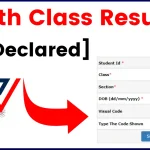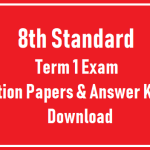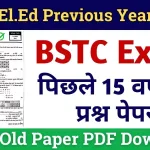The 8th standard government question paper for 2023 covers various subjects that are essential for students to focus on. It is designed to help students prepare for their exams by testing their knowledge and understanding of different topics. This article will provide a detailed question-and-answer format for every subject, ensuring thorough preparation.
English
Question: What is a noun?
Answer: A noun is a word that represents a person, place, thing, or idea.
Question: Give an example of a proper noun.
Answer: An example of a proper noun is “John” or “India.”
Question: Define a verb.
Answer: A verb is a word that expresses an action or a state of being.
Question: What is an adjective?
Answer: An adjective is a word that describes or modifies a noun.
Question: What is the difference between a simile and a metaphor?
Answer: A simile compares two things using “like” or “as,” while a metaphor directly states that one thing is another.
Question: What are the tenses in English?
Answer: The tenses in English are past, present, and future.
Question: What is the purpose of punctuation?
Answer: Punctuation is used to clarify meaning by indicating pauses, stops, or other elements in sentences.
Question: Identify the subject and predicate in the sentence: “The cat sleeps on the mat.”
Answer: The subject is “The cat,” and the predicate is “sleeps on the mat.”
Question: What is a conjunction?
Answer: A conjunction is a word used to connect clauses or sentences, such as “and,” “but,” or “because.”
Question: Explain the difference between active and passive voice.
Answer: In active voice, the subject performs the action. In passive voice, the subject receives the action.
Question: What is a direct object?
Answer: A direct object is a noun or pronoun that receives the action of the verb.
Question: What is an indirect object?
Answer: An indirect object is a noun or pronoun that tells who or what benefits from the action.
Question: What are articles in English grammar?
Answer: Articles are words like “a,” “an,” and “the” that define the noun as specific or unspecific.
Question: What is a preposition?
Answer: A preposition is a word that shows the relationship between a noun and other words in a sentence.
Question: Identify the correct form of the verb in this sentence: “She (go/goes) to school every day.”
Answer: The correct form is “goes.”
Question: What is a compound sentence?
Answer: A compound sentence is made up of two or more independent clauses joined by a conjunction.
Question: What is an interrogative sentence?
Answer: An interrogative sentence is a sentence that asks a question.
Question: Write a sentence using an adverb.
Answer: She runs quickly to the bus stop.
Question: What is the purpose of an exclamation mark?
Answer: An exclamation mark is used to show strong feelings or emphasis.
Question: Define a homophone.
Answer: Homophones are words that sound the same but have different meanings and spellings.
Mathematics
Question: What is the sum of angles in a triangle?
Answer: The sum of angles in a triangle is always 180 degrees.
Question: Define a rational number.
Answer: A rational number is a number that can be expressed as a fraction of two integers.
Question: What is the perimeter of a rectangle?
Answer: The perimeter of a rectangle is the sum of all its sides, calculated as 2(length + breadth).
Question: What is the area of a circle?
Answer: The area of a circle is given by the formula A = πr², where r is the radius.
Question: What is a prime number?
Answer: A prime number is a number greater than 1 that has no positive divisors other than 1 and itself.
Question: How do you calculate the volume of a cuboid?
Answer: The volume of a cuboid is calculated by multiplying its length, breadth, and height.
Question: What is the difference between mean, median, and mode?
Answer: The mean is the average, the median is the middle value, and the mode is the most frequent number in a set of data.
Question: How do you simplify the fraction 8/12?
Answer: To simplify 8/12, divide both the numerator and denominator by their greatest common divisor, which is 4. The simplified fraction is 2/3.
Question: What is the Pythagorean theorem?
Answer: The Pythagorean theorem states that in a right triangle, the square of the hypotenuse is equal to the sum of the squares of the other two sides.
Question: What is the circumference of a circle?
Answer: The circumference of a circle is given by the formula C = 2πr, where r is the radius.
Question: What are complementary angles?
Answer: Complementary angles are two angles that add up to 90 degrees.
Question: What is the value of π?
Answer: The value of π is approximately 3.14159.
Question: What is a decimal?
Answer: A decimal is a number that represents a fraction of 10, written using a decimal point.
Question: How do you convert a fraction to a percentage?
Answer: To convert a fraction to a percentage, multiply the fraction by 100.
Question: What is a mixed number?
Answer: A mixed number is a whole number combined with a fraction, such as 2 1/2.
Question: What is the LCM of 4 and 6?
Answer: The least common multiple (LCM) of 4 and 6 is 12.
Question: What is the HCF of 8 and 12?
Answer: The highest common factor (HCF) of 8 and 12 is 4.
Question: What is the difference between an acute and obtuse angle?
Answer: An acute angle is less than 90 degrees, while an obtuse angle is greater than 90 degrees but less than 180 degrees.
Question: What is a factor?
Answer: A factor is a number that divides another number exactly, without leaving a remainder.
Question: How do you solve linear equations?
Answer: To solve linear equations, isolate the variable by performing inverse operations on both sides of the equation.
Science
Question: What is photosynthesis?
Answer: Photosynthesis is the process by which plants convert light energy into chemical energy in the form of glucose.
Question: What is the function of the human respiratory system?
Answer: The human respiratory system is responsible for taking in oxygen and expelling carbon dioxide from the body.
Question: What is an ecosystem?
Answer: An ecosystem is a community of living organisms interacting with each other and their environment.
Question: What is the difference between a plant cell and an animal cell?
Answer: A plant cell has a cell wall and chloroplasts, while an animal cell does not.
Question: What is gravity?
Answer: Gravity is the force that attracts objects towards the center of the Earth or any other celestial body.
Question: Define force.
Answer: Force is a push or pull that can change the motion of an object.
Question: What is the water cycle?
Answer: The water cycle is the process by which water circulates through the atmosphere, land, and oceans.
Question: What are the three states of matter?
Answer: The three states of matter are solid, liquid, and gas.
Question: What is the role of the heart in the circulatory system?
Answer: The heart pumps blood throughout the body, supplying oxygen and nutrients to tissues and organs.
Question: What is an acid?
Answer: An acid is a substance that releases hydrogen ions (H+) when dissolved in water.
Question: What is a physical change?
Answer: A physical change is a change in the appearance or state of a substance, without changing its chemical composition.
Question: What is a chemical reaction?
Answer: A chemical reaction is a process in which substances interact to form new substances with different properties.
Question: What is the function of the roots of a plant?
Answer: The roots anchor the plant in the soil and absorb water and nutrients.
Question: Define the term “habitat.”
Answer: A habitat is the natural environment in which an organism lives.
Question: What is a compound?
Answer: A compound is a substance formed when two or more elements chemically bond together.
Question: What is the difference between conductors and insulators?
Answer: Conductors allow electricity to flow through them, while insulators do not.
Question: What is the main function of the digestive system?
Answer: The digestive system breaks down food into nutrients that the body can absorb and use for energy.
Question: What is the role of the immune system?
Answer: The immune system protects the body from harmful pathogens like bacteria and viruses.
Question: What is the process of respiration?
Answer: Respiration is the process of releasing energy from food molecules, mainly glucose, in the presence of oxygen.
Question: What is the difference between a compound microscope and a simple microscope?
Answer: A compound microscope uses two lenses to magnify an object, while a simple microscope uses only one lens.
The 8th Standard Government Question Paper 2023 covers a variety of subjects, helping students prepare efficiently for their exams. By practicing these questions and answers, students can strengthen their understanding of the key topics in each subject and perform well in their exams.
Latest Posts
- Step-by-step guide to download and apply for jee mains admit card 202
- Comprehensive 2025 government holidays and recruitment details for job seekers
- JEE Mains Admit Card 2025: Your Step-by-Step Guide to Downloading the Hall Ticket
- Everything You Need to Know About 2025 Government Holidays Recruitment
- Comprehensive Guide to rrb d group recruitment 2025 – Eligibility, Vacancies, and Application
- Detailed guide to nps trust recruitment 2025 vacancies, eligibility and apply process
- Comprehensive guide to hpcl recruitment 2025 notification, vacancies, and application process
- ignou bed admission 2025 complete recruitment guide with eligibility and process
- Comprehensive Guide to Indian Army Agniveer Recruitment 2025 Notification and Jobs
- Everything You Must Know About CBSE Board Exams 2025 Changes & New Rules






